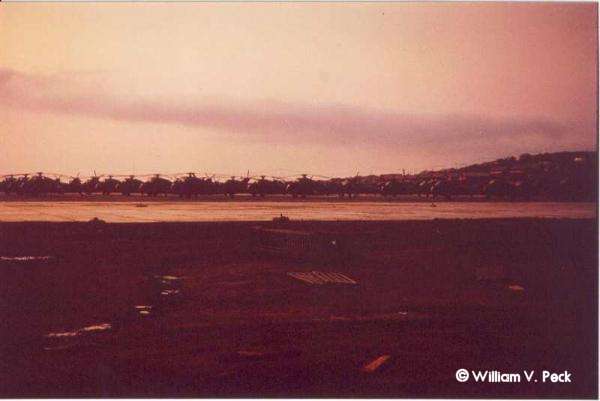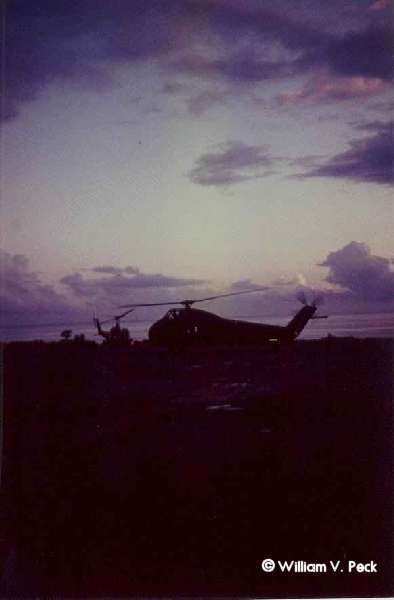
I was sitting in the bleachers at the Reno Stead Airport waiting for the days events to start. The sky was still dark with just a trace of light blue on the eastern sky line. When off to my left a sound drifted across the ramp that of a Pratt Whitney 3350 radial engine being fired. The wheezing, whining, bilging, popping growling noise that only a reciprocating engine makes when starting and suddenly I was taken back to days long ago of my youth.
It is now late November or early December 1965 an all out effort for on for the next day. The MCAB at Ky Ha Viet Nam held three squadrons of UH 34D Helicopters powered by a nine-cylinder air-cooled Wright R-1820-84 reciprocating engine each with 24 Aircraft and one squadron of HU1Es. Every Aircraft on the base except for hanger queens were to be used on this operation. We had been released from the flight line around 2200 that evening and had a zero dark thirty reveille. All the crews and maintenance personnel shook them selves into action and began making it back to the flight line. The Mess hall would not be open for two or more hours so breakfast was out of the question and c-rations were eaten if a person was lucky enough to have stashed a can or two. All that could be seen were shadowy figures walking in the direction of the flight line.

The flight line is a large slab of earth covered by any number of artificial man made materials. Its sole purpose is to house other man made objects that are of little use while sitting there. As you approach the flight line the shapes of the aircraft and tents begin to take shape. There is little or no activity and there are only a few of the tents with any lights on. The Aircraft begin to loom larger and more defined as you near the edge of the flight line. The maintenance crews begin by checking into their shops while the crew chiefs and mechanics check into the line shack. The gunners for the day will after checking into their respective shops begin drifting to the line shack for their aircraft assignments and then to the armory to draw their weapons. So begins the chaotic activity that will last for the next couple of hours.
The flight line is no longer place of inert and idle activity as the crew chiefs and mechanics begin to go to their respective aircraft and begin the pre flight inspection process of fuel inspections, opening the panels and doors, checking all the connections and flight controls. The crews have checked the yellow sheet to see that any gripes that had been written up have been corrected. One or more of the ground handling machines are fired up and the gunners begin to move the weapons and ammo from the armory to their assigned aircraft. Now the flight line becomes a living squirming thing filled with moving men and machines the noise level is higher as all four squadrons are doing the same thing at the same time. The eastern horizon is still holding on to darkness.

In about an hour the pilots begin drifting into the squadron areas. They will go to flight equipment and the S2 area for their final briefings then they will go to the line shack and get their respective aircraft assignments. They too will read the yellow sheets and sign for their aircraft. Then they too will begin to makes their way to the aircraft. More activity has been added to the flight line. The eastern horizon now has a faint shade of blue as the eternal struggle of night and day gets ready to cycle itself yet again.
The pilots will meet with the crew and give them their mission briefings and the pilot will check the aircraft prior to the crew chief closing all the panels. When all this has been accomplished the crews will mount their aircraft. The crew chief will take a position in front of the aircraft were the pilot can seen him and with hand signals begin the turn up procedure.
For a brief moment there is only the sounds of the ground power units, the wakasau power units or the APUs (auxiliary power units) then as if a conductor of chaotic noise has taken up the baton the air is shattered by the wheezing, whining, bilging, popping growling noise that only a reciprocating engine makes when starting except it is now multiplied by 72 engines all trying to start at the same time. Above this chaotic symphony can be heard the whining whistle of the Hueys as they too come to life. Slowly the wheezing, whining, bilging, popping growling noise gives way to a smooth powerful snarl as the engines fire and reach idle speed. The Huey's blades have begun turning then the UH-34D's blades begin to turn and the pitch of the engines becomes deeper and more throaty in tone. The ground rumbles from the pulsating engines and the noise can now be felt and heard at the same time. The air becomes thick with the odor of burnt Avgas and jet fuel. The eastern sky line has turned a brighter blue and dawn is breaking.
Then as if by magic these man made devices begin to move first out to the brief runway making a turn and flight power is added and in groups of one and two aircraft begin lifting from their earthly bonds and again become useful objects. Finally and as quickly as it all had started there is a deathly silence as if the conductor of chaotic noise had laid down his baton as all the aircraft have departed for the days mission. The flight line is empty and now serves no purpose until the aircraft again return. The sun has just broken the eastern horizon.
From my left the throaty roar of a fixed wing aircraft comes to full song and as if by magic a P-51D plane roars into sight its wheels folding into the wings as the plane reaches for its rightful place and I am again in the bleachers at the Reno Stead airport and another day at the National Air Races has begun. The sun has just broken over the eastern sky line.
MSgt. William V. M. Peck's History Index
Back Browser or Home
-